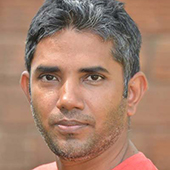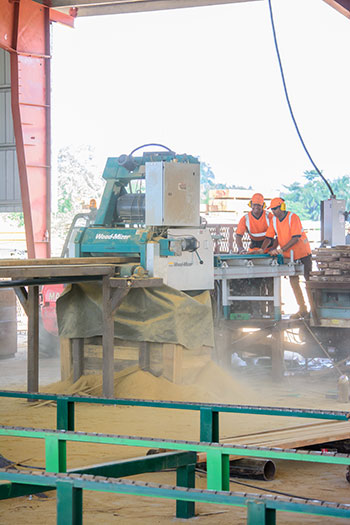
– Can the battle be won?
The story of Guyana’s forestry sector is replete with tales of wanton destruction by companies, large and small, which engage in unstainable management practices. In the eyes of the common man, that translates to companies bulldozing the forest, doing whatever they want with the trees they cut, and getting rich in the process.
Indeed, forestry expert Dr Janette Bulkan has argued that Guyana is a “pariah” state, painting a picture of rogue operators trampling the law; and she contends there is no evidence to prove otherwise.
“…there have been no changes in policy and no evidence of the non-selective implementation of policy to demonstrate that Guyana is other than a pariah,” Bulkan said in a letter to the press in early October this year.
But Farfan and Mendes ltd, which ironically introduced the chainsaw to Guyana, and its forest sector investment partner, Mc Vanatage of Guyana Inc, is out to prove Bulkan and other fierce critics like her wrong.
Well, not just Farfan and Mendes and Mc Vantage.
Forestry producers, those who either engage in the timber trade or produce wood products, are frustrated over the fact that they are already buckling to meet stringent regulations while bearing the weight of an unfair label and the alarm the recent UK ban on greenheart imports has raised.
Cut above the rest
“In terms of what we do in the forest and how we extract, it is all sustainable management,” says Andrew Mendes, Managing Director of Farfan and Mendes.
He is unapologetic that his business is about making money but none of what he does ducks the sometimes tedious regulations set up by the Guyana Forestry Commission (GFC).
And it is no idle boast.
Farfan and Mendes is the company that has teamed up with the Iwokrama centre for rainforest conservation to show how the forest can be used in a sustainable manner.
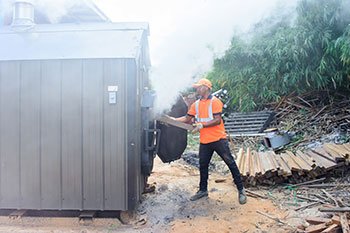
In mid-October, the operations received certification from the Forest Stewardship Council (FSC), making the Iwokrama forest the only area in Guyana that has been certified for meeting international best practices for forest management. At the same time, Mc Vantage of Guyana Inc also received its FSC Chain of Custody Certificate.
“FSC certification is the highest international accolade that forest Managers can receive and it is testament to the Centre’s application of international social, ecological and environmental best practices in its management of the Iwokrama Forest,” the Iwokrama Centre stated when the certification was announced.
The FSC certification essentially means that the UK greenheart ban does not affect Farfan and Mendes and Mc Vantage.
The harvesting and processing of greenheart trees, which makes up 50% of the volume of trees cut from the Iwokrama forest, is done by Farfan and Mendes’ sister company Mc Vantage of Guyana Inc, which is a partnership with the Mc Vantage Group of Companies of the United States.
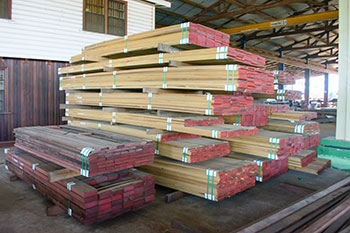
The Mc Vantage advantage is a smooth operation that is a cut above the rest.
The typical sawmill in Guyana is a picture of chaos: Pieces of wood (meant for the market)are strewn all over; “strippings” and “slabs” piled up for a cheap sale; sawdust being dumped into the waterways, as is the case with those along the rivers; and you would see men wrestling with wood to get it onto the ripping machine.
The Mc Vantage mills though, located at both Iwokrama and Coverden, East Bank Demerara, are a completely different operation. There is no chaos – no scenes of men crawling over the sawmill struggling to get the cuts they want and no pictures of lumber – cut or waste – scattered about.
And that’s because of the expertise that comes with Mc Vantage.
The company reasons that in cutting an order out of log production gets halved; that’s the typical way local sawmills operate, resulting in a lot of waste. In addition, this method carries the grade recovery down by half.
What Mc Vantage does is to cut for whatever high grade lumber they can get out of a log, no matter the length or width.
“You can’t saw for size and grade at the same time. If as I saw into a log and I see a defect, I turn to the side to cut around that defect to maximize the volume of high grade lumber I get out of each piece,” Mendes explains. As a comparison, local sawmills average an export grade recovery of lumber sawn of 30 -50%. By comparison, Mc Vantage averages 80 – 90 percent in export grade from the sawn lumber volume, without any losses in overall recovery from the round log.
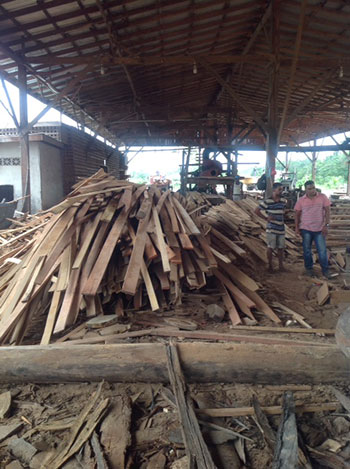
From what they get, the wood is then stacked neatly and left to dry.
What should be a common sense rule of stacking the wood neatly and ensuring that it is dried properly is often ignored by most sawmills, which dump the lumber haphazardly in bundles which eventually leads to uneven drying and badly distorted lumber – as a consequence further reducing the value of the lumber they spent so much to produce.
“Wood becomes stable once you dry it. Once you dry it, then you start ripping after drying into specific sizes, and then you don’t get as much bowed or twisted lumber.
“Sustainability…means using as much of the tree and extracting as much value from the tree you cut down than how many trees you cut down,” says Joe McKinney, president of the Mc Vantage Group of Companies.
“Sustainability has to do with how much useable and valuable product you get out of every tree you cut down; and the more useable product I get the more trees I can leave,” he added.
“The easiest way to make more dollars is to do less work, which means don’t cut as many trees down, don’t drag as many trees out of the forest, don’t , don’t don’t…and if you make more money doing that, then that’s sustainability.
“Doing it this way allows us to get a much higher yield of high grade wood which we get top dollar for while minimizing the cost of production, which equals profit – so profit and the environment are not conflicting goals,” Mendes asserts.
Mendes, who has conducted hundreds of training workshops with mills across the country, admits that there is a lot of wastage.
“We do have a lot of wastage; that needs to be improved. But it is not going to happen overnight and you need to provide some sort of leadership –you can’t “regulate” change, but need to incentivise it,” said Mendes.
Mc Vantage Guyana is providing that. Its operation is open to anyone who would want to have a look and share their knowledge freely.
“Anybody is welcomed to come and see anything we do. Not going to build a zinc fence and hide what we do,” says Mendes.
Mc Vantage built the Coverden facility so that it can handle more lumber than its sawmill will run for the simple reason that it want to purchase from other millers in the country. That means that the mills will have to up their game.
They will not go to a miller and say they want a particular size; they will instead buy random lengths and random widths but at a different price based on the grade of the lumber.
One of the mills that has seen the wisdom of transforming their operations is Cummings Wood Products, which recently set up another company called Floor It Guyana.
Andre Cummings, the owner, said that before, the way his machines were set up and the way wood was piled restricted movement and that resulted in a lot of down time and inefficiency.
Before, he was sharpening and reusing some tools, but not anymore, realising that getting new insert, throwaway tooling allows the company to maintain consistency and quality in the finished product.
He said that Mc Vantage “sat and spoke with us and gave us practical advice on how to do things differently.” They were also flown to the US to observe operation there in order to to improve quality and efficiency.
Mendes hopes that that transformation can occur throughout the industry as this will help to erase forestry’s bad image and improve quality and therefore sustainability throughout the industry.

Greenheart ban
Guyana is made up of a total land area of 21 million hectares, of which 18.3 million hectares are forested. Of the forested area, 12.8 million hectares is state forest administered by the GFC.
Mendes insists that the industry is heavily regulated and the regulations are being followed – and there is proof.
Take the harvesting of greenheart, for example.
Greenheart, also known as Cogwood, Demerara Greenheart, Greenheart and Bibiru, is available in commercial quantities only in Guyana and is prized for its strength and durability, making it a preferred wood for marine construction especially.
In May 2015, the United Kingdom Environmental Agency advised its contractors that it would no longer take greenheart from Guyana for UK government contracts because Guyana was not considered a “legal and sustainable” source for greenheart.
The agency stated: “A decision has been made that we will apply the timber procurement policy rigorously and that we will only buy timber from legal and sustainable sources.
“This currently prohibits the purchase of new greenheart (from Guyana) as it does not have sufficient evidence (based on UK Government requirements) that the forests of origin are sustainably managed.”
The Guyana Manufacturing and Services Association (GMSA) argued that this statement in effect brands all timber species and products as unacceptable and explained this to the Minister of Business by way of a letter on April 15, 2016.
In the letter, the GMSA referred to the findings of an on-the-ground study of the management of five forest concessions and a wider pre and post-harvest evaluation in 16 concessions.
The study was done by the GMSA’s Wood Sector Group, together with the Forest Products Association and the Guyana Forestry Commission.
The analysis showed that greenheart is not being overharvested, and sufficient stocks remain that allows for sustainable harvesting over future generations.
Of the concessions surveyed, it was found that only 822 greenheart trees were actually harvested out of the 2, 630 trees that were recorded for potential harvest within the sustainable yield of the forests. Of the trees not harvested, it was found that over 2, 000 other trees would reach a “merchantable” size within the 60-year felling cycle. (GFC rules are that a concession can only be harvested once every 60 years.)
Of the 16 larger concessions that were monitored, it was found that only about half of the trees that could be cut were actually cut, giving confidence that in the next cutting cycle in another sixty years there would be more than the allowable volume to cut.
“This kind of evaluation and ‘ground truthing’ was never done before. It proves conclusively that although there are no certified forests in Guyana (excluding the Iworkrama forest, which has now being certified) harvesting is carried out sustainably and that felling rates for greenheart are lower than the projected regeneration rates,” the report stated.
This, forestry stakeholders said, is adequate evidence for the UK Environmental Agency, to reverse its ban on greenheart into the UK.
The stakeholders, like Mc Vantage Guyana, said Guyana is committed to sustainable forest management and this is evidence by the compilation and execution of the National Forest Plan and the National Forest Policy Statement, together with the Code of Practice for Forest Harvesting and the Code of Practice for Wood Processing.
“This industry is well regulated and operates in consonance with the Environmental Protection Agency, with national and international requirements for Occupational Health and Safety, Labour and Social Protection,” the GMSA stated in its letter to the Minister of Business.
It has also been pointed out that recent studies have confirmed that logging is done on a low intensity basis. For example, independent internationally recognized auditors such as the Norwegian Company Det Norkse Veritas (DNV), and GFA Consulting of Germany, have confirmed that Guyana’s deforestation rate using national scale 5 m satellite imagery resolution (Rapid Eye) was a mere 0.078 % in 2012, and even less in 2013 (0.069 %); there was a further decrease in 2014 (0.065 %).
The code of practice for harvesting (specific to the various categories of concessions) sets minimum operational standards including the requirement to plan for the selection of tree, tree- felling direction, skid trail layouts and the sub-division of concession into blocks which are managed on a 25 to 60- year cutting cycles with the allowable cut reduced to compensate.
The GFC monitor harvesting practices regularly, through a structured programme of field visits, complemented by random and impromptu visits. Currently there are 39 strategically located forest stations countrywide, and 14 mobile stations.
In addition, there is a comprehensive documentation and checking system inclusive of a national log tagging and tracking system.
This real time system uses barcodes, scanners, and concession specific tags which enable chain of custody assurance since each log can be traced back to the stump in the forest concession.
The log tags also serve as one control mechanism to guard against overharvesting; tags are used by the GFC in accordance with a harvesting quota that has been determined individually for each concession area.
“The greenheart study shows there is nothing unsustainable; the facts speak for themselves,” Mendes asserts.
He argues that if Guyana’s forestry operations were not sustainable, then Guyana would not have been able to benefit from the US$250 million forest-saving deal with Norway.
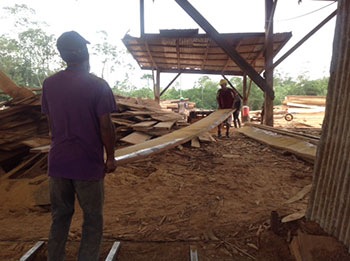
EU-FLEGT
Of recent, a new acronym has been hovering over the forestry sector, namely EU-FLEGT.
FLEGT stands for Forest Law Enforcement, Governance and Trade and was established in 2003. It aims to reduce illegal logging by strengthening sustainable and legal forest management, improving governance and promoting trade in legally produced timber.
Guyana is currently pursuing a Voluntary Partnership Agreement (VPA), a legally binding trade agreement with the European Union under FLEGT.
“The EU-FLEGT initiative will have a direct impact on the forest industry by giving Guyanese suppliers unrestricted access to the EU Market for agreed products,” said Kenny David, Assistant Commissioner of Forests at the GFC.
“Access to this market signals to the rest of the world that Guyana is serious about placing only legal timber on the markets,” adds David, who heads the FLEGT Secretariat at the GFC.
He posited that “one needs to remember as well that development of systems like these allows for the country to develop its own systems for tracking and tracing timber for both local and export markets; a benefit that any stakeholder should want.”
Mr David insisted that FLEGT is not seeking to bring any additional burdens on local stakeholders but that much of the systems that are currently being assessed for licensing have been in existence for many years.
He said that under the EU-FLEGT initiative, there will be efforts made to not only assess where local stakeholders have challenges (if any) in meeting the requirements, but also to provide the relevant support in addressing these challenges, if any.
“There are support measures which the EUFLEGT initiative will determine from consultations with stakeholders prior to this system being agreed upon.
“Additionally, the EU-FLEGT process will allow for an impact study to be carried out determining what will be the likely impacts on all stakeholders,” he stated.
Mc Vantage Guyana argued that process such as EU-FLEGT give credence to the fact that Guyana is not intent on escaping regulations or complying with international best practices, and that the bad-mouthing of the forestry operations here should end.
Mendes said the issue goes beyond having to prove that Guyana’s forestry operations are sustainable and “legal.”
As the entire sector argues, the false labelling of Guyana as a “pariah” state has a bearing on the livelihoods of the 26, 000 persons who are employed by the sector.



.jpg)







